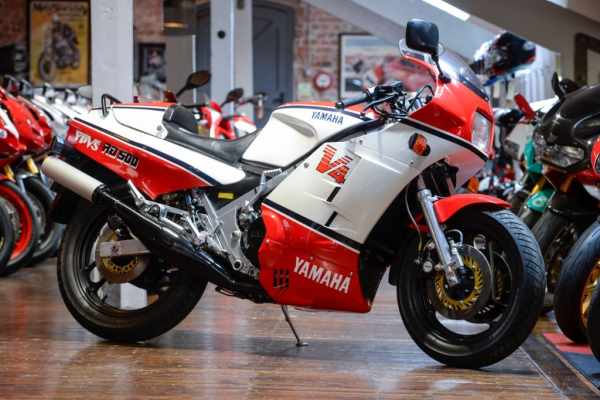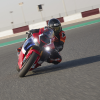
EVERYBODY knows everything there is to know about the ‘Elsie’, right? The much-loved RD350LC (LC, hence ‘Elsie, geddit?) launched in 1980 who’s blend of TZ-inspired, two-stroke twin, powerband potency combined with accessible, everyman affordability not only made it a sensation both on road and track it proved so significant in the formative years of a whole biking generation it remains a revered and envied classic to this day.
Back in 1980, for example, a 750-beating 350LC, of the sort seen on World of Sport and endorsed by no less than Barry Sheene, could be had new for just £1147. Today, after prices bottomed out in the mid-90s to under 500 quid, a decent, original runner won’t leave you any change from £7000.
Yamaha Tracer 9 and Tracer 9 GT announced
But – and here’s the point – it’s not the only one. While the term ‘LC’ most commonly conjures images of the ‘80 RD350LC, ‘Elsie’ actually applies to a whole dynasty of two-stroke Yamahas with many (but not all) available well under that £7K tag. So here, once and for all, are our Top 10 Yamaha Elsies, which, for the sake of avoiding an argument, are in chronological order (mostly). And, yes, before you ask, there were more than 10: We’re not including the last, horrible, mongrel of the breed: the neutered, Brazilian-made, 1992 RD350R. Because it’s rubbish.
1980 RD250LC
Everybody (again) remembers the 1980 RD350LC but most also forget that it was its little brother, the RD250LC, that actually arrived first – and in many ways it’s the quarter-litre version that’s more significant. Built to satisfy the then 250cc L-plate law it arrived in March 1980 (production problems meant the 350 didn’t land until June, with those with delayed orders being compensated with a specially-stickered Bell Star helmet) and it immediately caused a sensation. Apart from being 247cc and 35bhp compared to the 347/47bhp 350, having a single not dual front disc and horn, different rear wheel and smaller brake master cylinder, the 250 was identical – and almost as fast. So much so, in fact, that reports of it being ‘the first 100mph 250’ (this is still debated) led to a new 125cc learner law being rushed in starting February 1983. Being L-plate eligible also led to the 250LC being hugely popular and in turn led (once it was irrelevant for the road) to the creation of a popular 250LC club racing class in the late ‘80s when you could buy a thrashed racer for around £400. Today restored examples are nearer £5000 but watch out – many have been converted to 350 spec. 250 engine/frame numbers start 4L1, 350 4L0…
1980 RD350LC
The holy grail of LCs. The RD350LC was the successor to the air-cooled RD400, inspired by Yamaha’s then racing TZ350 (hence the liquid-cooling, cantilever single shock and white/black colours) and, as it was aimed primarily at Europe not the USA (where tightening emissions laws effectively outlawed performance two-strokes), it was largely developed by Yamaha Europe in Amsterdam, with significant input from Brits Paul Butler (later manager of Kenny Roberts’ GP team), ex-Norton-Villiers-Triumph stalwart Bob Trigg, stylist Mike Ofield and test rider Dave Bean. The bike itself was brilliant – good looking, fast, exciting, decent handling and affordable. But around it was a ‘perfect storm’ of circumstances that thrust the LC into the consciousness of impressionable early ‘80s youth like nothing else – before or since: its 250 sibling made it even more accessible, many progressing from one to the other; there was the televised ProAm race series; adverts featuring Barry Sheene; a mass of accessories including expansion pipes and ProAm fairings the list went on. Today, despite arguably better successors, the ’80 350LC (the ’81 was also available in black, the contrasting stripes of ’83 bikes had three, not two colour bands) remains one of the most desirable of all ‘modern classics’, something helped by it being easy to work on with spares generally plentiful…
1982 RD125LC
Following the announcement of a new 125cc learner law from 1983 Yamaha immediately developed a new LC to comply – the RD125LC, first arriving in showrooms in 1982. In most respects the new quarter-litre bike carried over the LC DNA and even enhanced some of it. The engine was a new liquid-cooled single producing a restricted 12.2bhp, styling was an evolution of the 250/350’s but with ‘ProAm’ style nose fairing and belly pan as standard and there was a similar cantilever monoshock at the rear but this time fashioned from uprated, box-section aluminium. Although, at £820 new, it was also the most expensive of the new breed of 125s, it, along with its trail bike styled DT brother, was a huge success. And although, necessarily, not matching the 35/47bhp thrills and excitement of the 250/350 originals, the 125LC was also hugely significant to a generation of riders. It remained in production until replaced by the TZR125 in 1987 and good, restored examples easily fetch well in excess of £2500 today.
1982 RD80LC
Introduced alongside the RD125LC is an even smaller LC and one that is far less recognised and understood – the RD80LC. Sold in the UK between 1982 and 1984, the smallest LC was aimed primarily at more ‘tiddler-friendly’ markets such as Spain and Italy but also succeeded in being a true ‘Elsie’ and one that’s arguably the cutest and most exclusive (certainly in the UK) of all. Powered by a liquid-cooled, 79cc single it produced 8.7bhp and carried it in a miniaturised chassis that was ‘LC correct’ right down to its ‘italic’ wheels, white/black livery, TZ-alike exhaust and ProAm fairings. On the plus side it was cheaper to buy and insure than the 125, although its spindly, diminutive proportions put off some. Now, however, their rarity adds to the appeal with good ones (if you can find one) going for as much as £4000.
1983 RD350YPVS
The successor to the original RD350LC came quickly – in under three years – and was an equally brilliant bike with improvements all round, modernised styling, more power (59bhp from 47bhp) plus, of course, its defining ‘power valve’. As such, it’s almost as desirable as the original and arguably more usable and versatile thanks to its improved suspension (a rising rate monoshock replaced the LC’s cantilever) and a smoother power delivery. What it’s NOT, however, as any purist will tell you, is a true ‘LC’. It’s a ‘powervalve’. It’s different. One of those differences was that there was no longer a 250 version (although there was in Japan), which in itself somehow made it less significant. On the plus side, though, it was a far better performer (albeit without the LC’s addictive 6000rpm powerband), more versatile, more modern looking, better braked and also now came with bikini fairings as standard. It came in white/red or black/red, was confusingly relaunched into the US (with a power-sapping catalytic converter to hep it get round emissions regs) in Kenny Roberts yellow/black livery and good examples today will also cost you £7K.
1984 RD350N
After just one year the YPVS was replaced by not one, but two new variants – the naked RD350N and the fully-faired RD350F. Both had a slightly different approach to previous LCs. Following the arrival of more high tech two-strokes such as Suzuki’s alloy-framed, 250GP-alike RG250 and emerging performance middleweight fours such as Honda’s VF500F and CBX550, Kawasaki’s now-Unitrak GPz550 and Suzuki’s GSX550F, Yamaha decided the relatively simple, low tech RD could no longer compete in terms of spec and performance so chose to emphasise its more affordable fun factor instead. Of the two, the N was the bargain-priced hooligan with low clip-on bars, which gave it a more aggressive riding position that proved an absolute hoot. That said, today it’s also considered to have neither the cache of the original YPVS nor the more modern looks and spec of its restyled successor, the RD350N2, so is one of the least appreciated of all LCs.
1984 RD350F
The RD350F was launched alongside the RD350N (above) in 1984 and shared a virtually identical spec aside from its full-fairing (including fairing-mounted clocks) together with higher handlebars giving a more relaxed, long-legged and versatile machine that proved to be a true, budget-priced all-rounder. Fairing and designation aside, however, both it and the N were little changed from the YPVS and as a result, both are today also viewed as somehow ‘less’ than the original YPVS and valued accordingly, although, in reality, they perform almost identically. But if you want a flavour of the original LC in a practical package and at a bargain price, this is the one.
1986 RD350N2
By 1986 the motorcycling world was a very different place to 1980 when the original LC was launched. Performance two-strokes had peaked with the frenzy over Yamaha’s RD500LC along with Honda’s NS400R and Suzuki’s RG500 in 1985 while middleweight sportsbikes had a new king in the form of Kawasaki’s liquid-cooled GPZ600R which would spark a whole new 600cc supersports class. That left Yamaha’s RD350 duo now more affordable hooligans rather than as the superbike beaters they once were. Yamaha gave both one final fillip for 1987. Both got a power boost to 62bhp, were lighter and had improved brakes but the biggest difference was new, smoother, simpler bodywork, including fuel tank, which freshened up its looks. Yet although the best performing of all LCs they’re hardly considered classics today.
1986 RD350F2
The faired version of the last, Japanese-built LC followed the same formula as the original, 1984 RD350F but with the same technical updates – new bodywork, updated engine and brakes, new exhausts, lighter wheels etc – as its naked sister, the N2. By now, however, although a decent, affordable bike, it was neither a giant-killing sports machine (the arrival of a new breed of sophisticated, liquid-cooled fours such as Suzuki’s first GSX-R750 and Yamaha’s own five-valve FZ750 had seen to that) nor a compelling, cutting edge sports two-stroke. Yamaha’s own beam-framed, racer-replica, 50bhp TZR250, first introduced that same year, for example, immediately made the RD350 seem old. Even so, the RD350 remained useful, affordable and straightforward and stayed in production until 1990.
1984 RD500LC
Although designated ‘LC’, Yamaha’s long-rumoured 500GP replica shared little of the everyman appeal of the original 350, was a 500 V4 so a far more sophisticated beast and yet was also so mouth-watering it simply has to be included in this list. The Yamaha was the first of the Japanese 500GP racer replicas to arrive in the summer of 1984 (and had been rumoured far earlier) and caused a sensation. Inspired by Kenny Roberts’ first V4 OW61 of 1982 yet actually styled more akin to the box-section-framed, square-four OW60 of the previous year, its YPVS-equipped V4 produced 88bhp, it had an in-vogue 16inch front wheel, box-section steel frame (there was also a Japan/Australia RZ version with an alloy frame) and looked the absolute business. In reality, Suzuki’s subsequent RG500 was faster and more raw while Honda’s N400 triple was more affordable and, arguably usable, but the RD500 remains an icon of the age, good ones now go for around £20,000 and, as such, it remains the ‘ultimate LC’.

